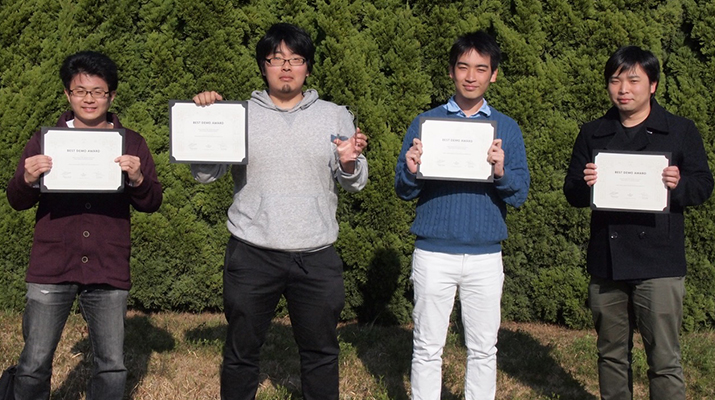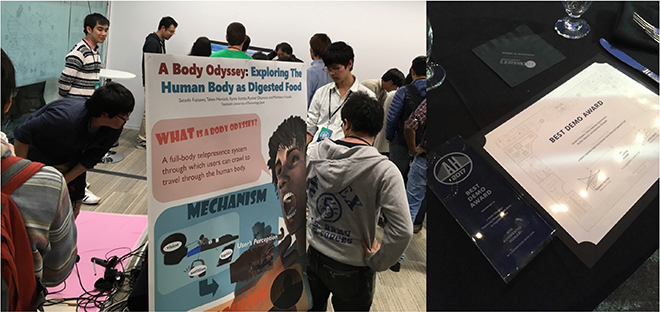
ここからコンテンツです。

A Body Odyssey
Virtual-reality experience for learning digestive organsThe "Augmented Human 2017" international conference at Silicon Valley, Best Demo Award
By Satoshi Fujisawa
A research team led by Satoshi Fujisawa, a graduate student of Department of Computer Science and Engineering at Toyohashi University of Technology has developed a system for experiencing a virtual trip in human digestive organs as a food by user’s crawling. The system contributes to enhancing learning and understanding on mechanisms of digestive organs because users have fun to experience the system as they are transformed to a food.
This system was presented in an international conference Augmented Human 2017 at Silicon Valley, CA, USA, 16th – 18th March 2017, and awarded "Best Demo Award."
Motivation for this research, struggles in research, and impressions after receiving the award
Satoshi Fujisawa wanted to develop an intuitive and enjoyable learning system to teach about health and physical education. His motivation for this came from his sense of regret that he had not been so interested in these topics during his school days. Since there were no previous studies relating to this field or to similar virtual-reality systems, the development was a gruelling process of trial and error. During their demonstration at the Augmented Human 2017 conference for example, the team experienced hardware trouble, which limited the effectiveness of their presentation. Naturally then, his team members were very surprised to hear that they had won the award for best demo.

Details of the research
Children study physical structure and the mechanisms of the human body using text books and anatomical body models as a part of Science or Health and physical education in elementary school and junior high school. However, these subjects are not interesting for children. Thus, Satoshi wanted to make a virtual-reality (VR) system to allow people to experience the inner body by themselves so that they can learn about digestive organs enjoyably.

The narrative of the developed VR experience is the journey of food, which becomes an avatar of the user. The food is eaten by a person, and travels through several digestive organs while getting digested. The food is digested gradually and the internal images of digestive organs are presented with 3-D information on a head-mounted Display (HMD), and users can look around them. Six digestive organs (esophagus, stomach, duodenum, small intestine, large intestine, rectum) were created in details based on text books, and specific movements of each organ were implemented. Users moved in the VR inner body by crawling, that was detected by pressure sensors on a soft matt. Four vibrators presented tactile sensations for improving the perception of self-motion. Headphones created 3-D sounds to accompany the movements of the digestive organs and heart beats.
Participants who experienced the system and said, ‘I enjoyed the sense of movement through the inner body’, ‘I became interested in the structure of the body’ and ‘I want to try other internal organs’. Thus, it is suggested that the VR system could contribute to enhancing scientific interest in the inner body and improving science learning.

Prospects
Satoshi, the team leader said, "I would like to create more VR systems, and provide novel and unimaginable experiences to many people."
Reference
Fujisawa, S., Hamada, T., Kondo, R., Okamoto, R., and Kitazaki, M. (2017). A body odyssey: exploring the human body as digested food. The 8th Augmented Human International Conference (AH '17), Silicon Valley, CA, USA, March 16-18 2017. [Best demo award] Proceedings of the 8th Augmented Human International Conference (AH '17), Article 39.
DOI: https://doi.org/10.1145/3041164.3041209.
Youtube video demonstration: https://youtu.be/mrMd7e1rTMQ
食物の旅
バーチャルリアリティによる消化器の学習体験国際会議Augmented Human(拡張人間会議) 2017, Best Demo Award受賞
By 藤澤 覚司
豊橋技術科学大学情報・知能工学専攻大学院生藤澤覚司率いる研究開発チームは、自分が食物となり、ほふく前進で身体内部の消化器を巡る旅を体験するバーチャルリアリティ体験システムを開発しました。このシステムを使うことで、自分の体験として消化器を学び、楽しく理解が促進されることが期待できます。
本研究の成果を、2017年3月16日から18日までアメリカのシリコンバレーで開催された国際会議Augmented Human 2017(拡張人間会議)においてデモ展示し、Best Demo Awardを受賞しました。
本研究に取り組んだきっかけ、研究の苦労話、受賞時のエピソード等
開発のきっかけは、私自身が興味を示せなかった保健体育の授業をVRでより直感的で面白いものにしたいと考えたことからでした。開発時は、先行研究や関連コンテンツがほぼなかったため、手探りでの開発となりとても苦労しました.デモ展示当日は、機材トラブルに見舞われ受賞はないだろうと諦めていたので、受賞アナウンスで作品名が読み上げられた時は、驚きました。
研究内容の詳細
学校教育では、教科書や人体模型をつかって理科や保健体育として人体の仕組みを学びます。しかし、それは子ども達にとってあまり面白い単元ではありません。そこで、バーチャルリアリティ(Virtual Reality;以下VR)を用いて、自分で身体内部を体験して、楽しく消化器を学習できる作品を作りたいと思いました。
ストーリーとしては、自分が食物となり、食べられてから徐々に消化され、排泄されるまでの旅を実現するものとしました。自分が食物になった様子や、移動中の消化器は、頭部搭載型ディスプレイに立体映像として提示され、見回すことができました。体験する消化器として、食道、胃、十二指腸、小腸、大腸、肛門を、参考書に基づき自らモデリングし、それぞれの消化器に特徴的な運動(蠕動運動など)も実装しました。体内の移動には、ほふく前進を用いました。圧力センサをつけたクッションの上で体験者が腕のほふく動作をすると、それを検出して前進するようにしました。移動時には、消化器の運動に伴う振動を4つの振動刺激装置から提示し、移動感を増幅しました。また、消化器の運動や心臓の鼓動を3D音響としてヘッドホンから提示しました。
本システムを利用した体験者は、「実際に体内を移動している感じがして楽しかった」、「身体構造に興味を持った」「他の臓器も体験してみたい」などの感想を示し、このシステムが身体内部の科学的興味、学習に貢献する可能性が示唆されました。
今後の展望
チームリーダの藤澤は、今後もさまざまなVRシステムを開発して、多くの人に普段体験できないような体験を提供していきたいと考えています。
Student Profile

| Name | Satoshi Fujisawa |
|---|---|
| Affiliation | Department of Computer Science and Engineering |
| Title | Master course student (2nd grade) |
| Fields of Research | Perceptual Psychology / Cognitive Neuroscience / Virtual Reality |
ここでコンテンツ終わりです。
